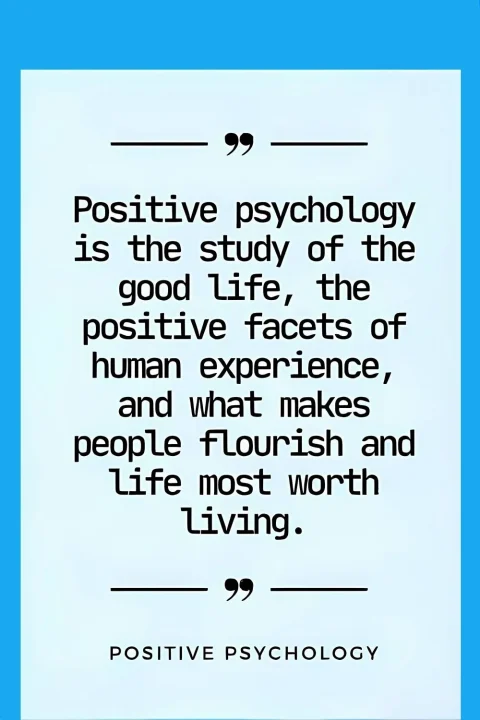Reading time: 33 minutes
What is positive psychology, beyond the science of happiness?Positive Psychology is popularly known as the science of well-being, but actually, it is the study of every aspect of human existence that makes our lives worth living.
The field was created to fill a void in psychology. Traditional psychology mainly focused on psychological diseases, neglecting the positive aspects of human life. Positive psychology began to investigate what makes us happy and mentally strong.
The mere absence of disease does not make us healthy. Similarly, happiness is not just the absence of sadness. And sadness can hide behind a smile.
• Download a PDF of this article (link in the Final Words section).
What Is Positive Psychology?
Positive psychology is the study of what makes our lives happier, more fulfilling, and more meaningful. It examines our relationships, our life’s purpose, and how we handle suffering. It studies practices that can boost our well-being, like gratitude, savoring, and mindfulness.
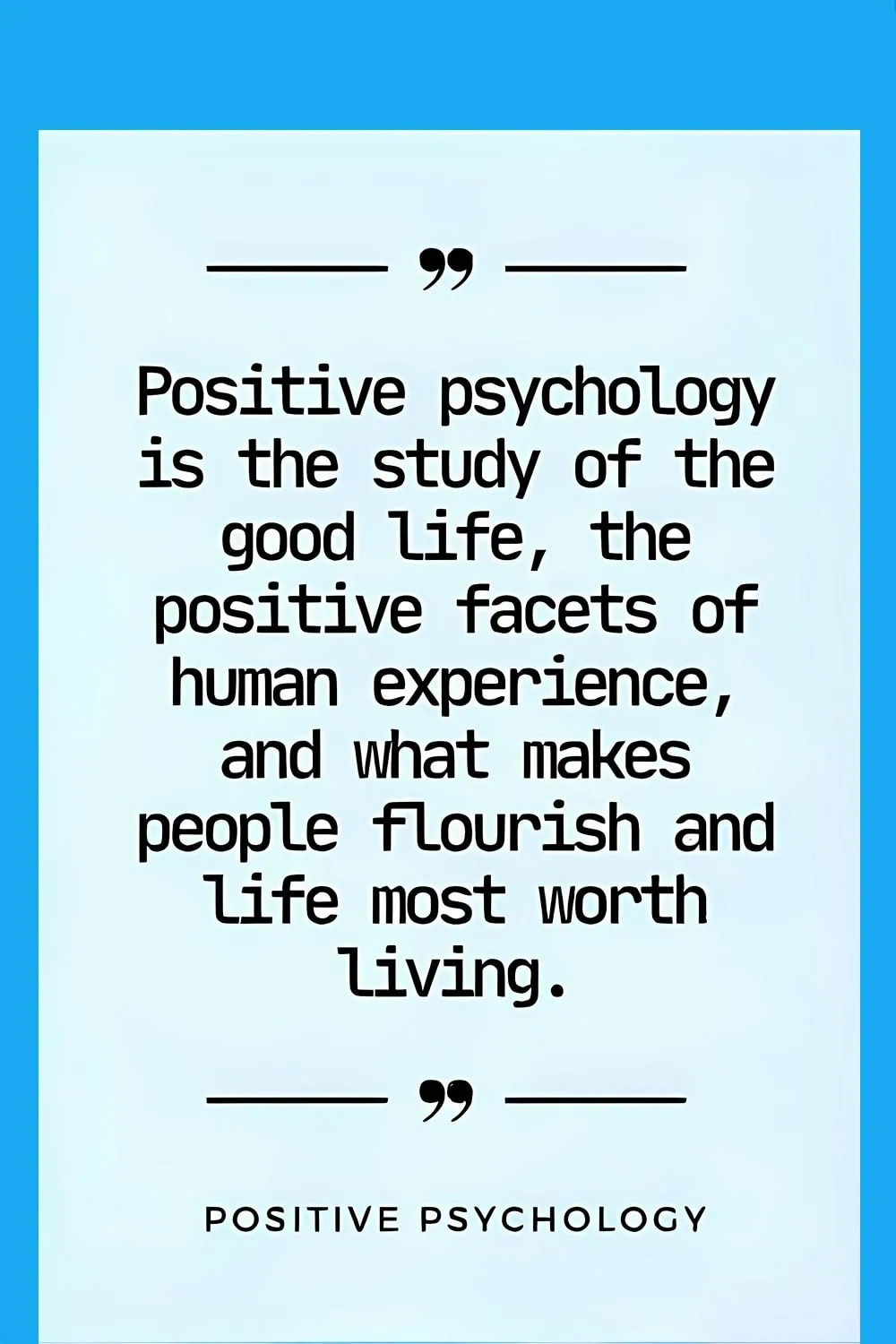
The field debuted in 1998 when Martin Seligman gave his presidential address to the American Psychological Association (APA). He invited eminent psychologists of the day to figure out how people and societies across the world could thrive better and live happier lives.
Since then, positive psychologists have been studying and revealing amazing facts about what makes humans flourish.
“Positive psychology is the study of how human beings prosper in the face of adversity.”
— Definition of positive psychology by Seligman and Csikszentmihalyi, 2000
Aims & Goals of Positive Psychology
Positive psychology is more than merely researching happiness and well-being. The goal is to understand what makes humans thrive beyond having moments of pleasure or positive emotions. It aims to unravel how individuals, communities, societies, and nations can thrive in a more meaningful, fulfilling, and sustainable way.
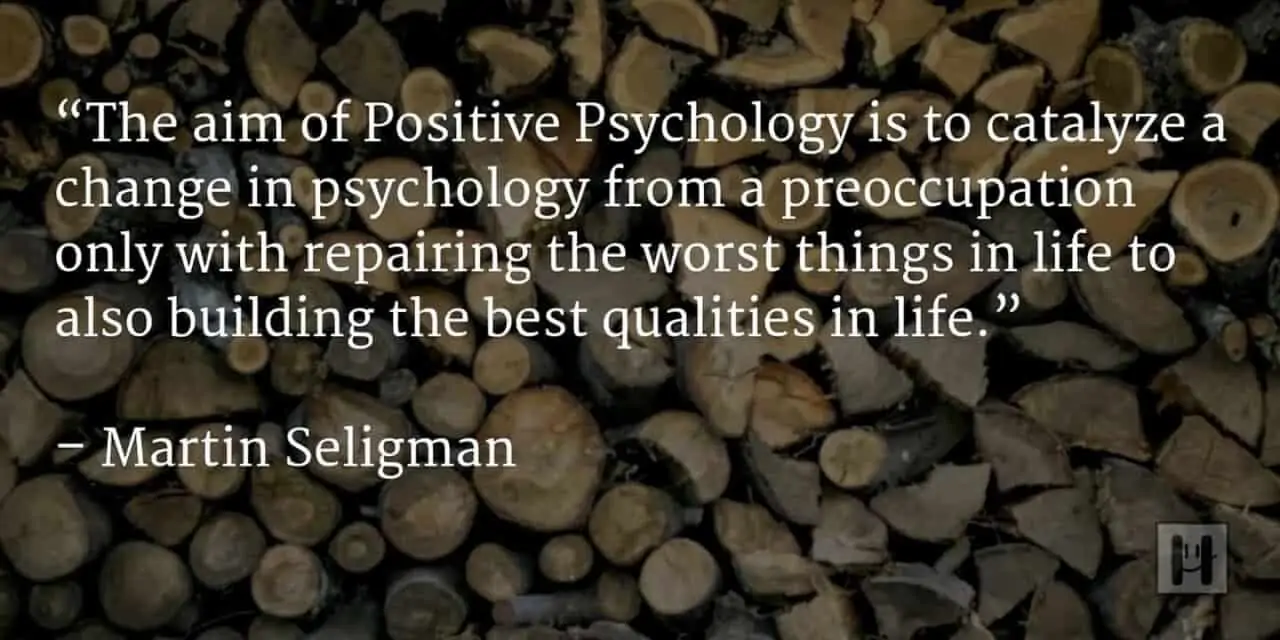
Initially, positive psychology theory focused on positive states, positive traits, and positive institutions (Seligman & Csikszentmihalyi, 2000):
- Positive states mean feeling great, feeling grateful, feeling proud, and feeling alive. Positive emotions are concerned with being content with one’s past, being happy in the present, and having hope for the future.
- Positive traits mean character, and also things like talents and interests that we consider to be positive characteristics, along with grit, self-control, kindness, sense of humor. Positive individual traits focus on one’s strengths and virtues.
- Positive institutions indicate our schools, our religious places, our sports teams, our cultural traditions, and the things that really support us in feeling good and being good. Positive institutions are based on strengths to better a community of people,
Later, it included meaning and purpose in life, good relationships, accomplishments, resilience, and suffering.
- Take special note, positive psychology is not a self-help-ish, feel-good fad, but a real scientific endeavor. Positive psychologists test hypotheses through double-blind studies to see if an insight holds or an intervention works.
- It does not minimize the contributions of other branches of psychology in treating mental health diseases.
- Positive psychology doesn’t ask people to ignore negative emotions or escape difficult situations.
- It reminds us that being positive doesn’t mean constantly forcing ourselves to be positive or smiling.
[Ever heard people say, “Everything happens for a reason” or “Just think positive”? That’s toxic positivity. That is unhealthy pressure to stay positive in difficult situations, pushing aside difficult emotions. It is not what positive psychology holds.]
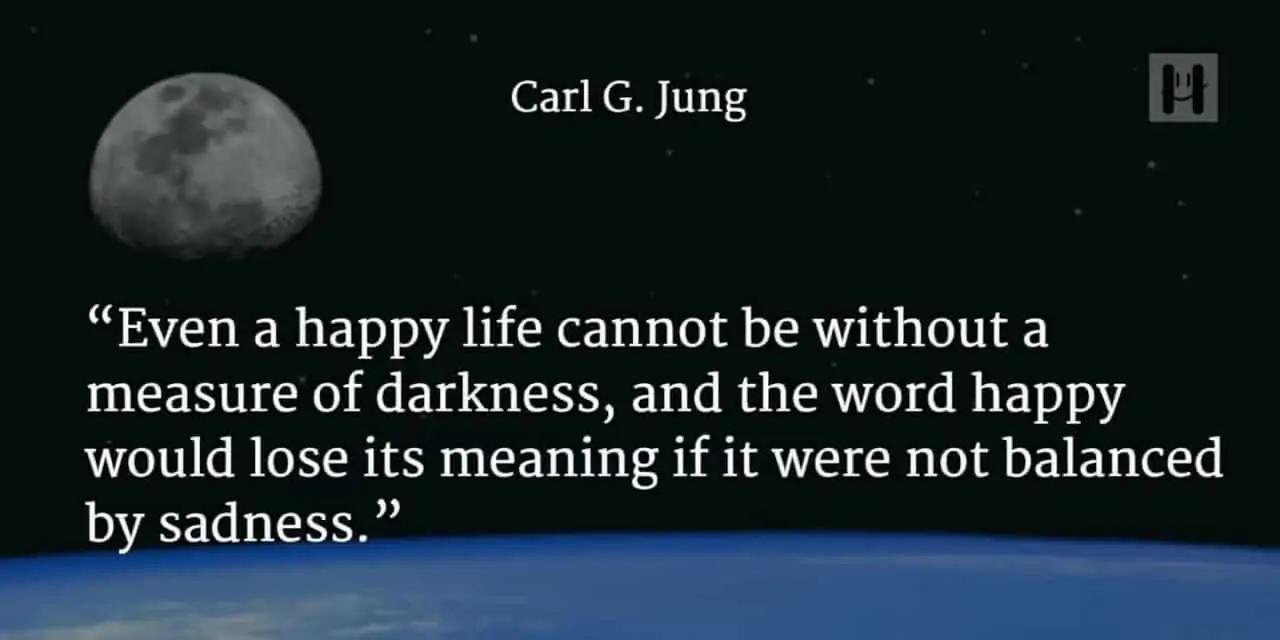
7 Key Aspects of Positive Psychology
- Happier: Positive psychology is about being happier. That is, moving up to a more fulfilling and flourishing state. For example, from +1 to +5. It complements traditional psychology’s focus on alleviating negative mental states, which helps people go from, say, -5 to -1.
- Strengths: As Martin Seligman explained, positive psychology devotes resources to the study of human strengths, virtues, and positive traits, such as hope, courage, gratitude, creativity, kindness, and resilience.
- Well-being: Positive psychologists study how some people function to achieve optimal mental well-being, and what makes their lives happier and worth living, despite distress and suffering. And share these strategies with us.
- Applications: The field has devised practical tools, like mindfulness activities and gratitude practice, to help people handle adversities better and emerge stronger and wiser.
- Fulfillment: It challenges the idea that a fulfilling life is only about pleasure and positive emotions. It rather looks at the entire spectrum of life to find out what makes it truly satisfying.
- Positive institutions: Positive psychology stretches its lens from individual focus to discover how institutions, organizations, and communities can thrive, and create happier and more fulfilling environments.
- Empirical foundation: As an empirical science, positive psychology relies on evidence gathered through observations and experiments to build and validate its theories. Its revelations and suggestions are based on data from real people.
History/Milestones In Positive Psychology
Some consider William James to be “America’s first positive psychologist” (Taylor, 2001). In his presidential address to the APA in 1906, James raised the question of why some people were able to utilize their resources to their fullest capacity and others were not.
Fifty years after William James’ APA presidential address, the term “positive psychology” first appeared in the last chapter of Abraham Maslow’s book Motivation and Personality (1954). The chapter was titled “Toward a Positive Psychology.”
- 1954: The term “positive psychology” was first used by psychologist Abraham Maslow in 1954 to emphasize being creative and self-actualized to achieve one’s full potential.
- 1998: In 1998, Martin Seligman was elected the president of the American Psychological Association, and he made Positive Psychology the theme of his term. In the first sentence of his book Authentic Happiness, Seligman wrote: “…for the last half-century psychology has been consumed with a single topic only — mental illness.” Today, Seligman is widely regarded as the Father of Modern Positive Psychology.
- 1999: The first Positive Psychology Summit took place in 1999.
- 2000: Martin Seligman and Mihaly Csikszentmihalyi define positive psychology as “a science of positive subjective experience, positive individual traits, and positive institutions.”
- 2001: Publication of the special issue of the “American Psychologist” journal dedicated entirely to positive psychology, edited by Martin Seligman and Mihaly Csikszentmihalyi.
- 2002: The First International Conference on Positive Psychology was held. Seligman publishes his bestseller Authentic Happiness: Using the New Positive Psychology to realize your potential for lasting fulfillment.
- 2003: “Handbook of Positive Psychology,” edited by C.R. Snyder and Shane J. Lopez, published. This work is considered a cornerstone in the field, as it compiled the burgeoning research and theory in positive psychology into a single comprehensive resource for the first time.
- 2004: Launch of the Masters of Applied Positive Psychology (MAPP) program at the University of Pennsylvania, the first program of its kind in the world. This program, led by Dr. Martin Seligman, aimed to train professionals in the application of positive psychology principles in various fields, including business, education, counseling, and healthcare.
- 2005: Martin Seligman and Christopher Peterson publish “Character Strengths and Virtues: A Handbook and Classification”. This book served as a counterpart to the Diagnostic and Statistical Manual of Mental Disorders (DSM), which is predominantly used to diagnose mental health disorders.
- 2006: The Happiness 101 course by Tal Ben-Shahar at Harvard University became wildly popular. The Positive Psychology Center at the University of Pennsylvania received a $5 million grant from the Templeton Foundation for the advancement of Positive Psychology.
- 2007: Initiation of the Master of Applied Positive Psychology (MAPP) program at the University of East London, the first program of its kind in Europe. This marked an important step in the international recognition and academic acceptance of positive psychology, demonstrating the global interest and applicability of this burgeoning field.
- 2008: The Gallup Organization launches the Gallup-Sharecare Well-Being Index, a unique partnership in research and care that surveys 1,000 Americans every day.
- 2009: The International Positive Psychology Association (IPPA) held its first World Congress on Positive Psychology in 2009 in Philadelphia, United States.
- 2010: Shawn Achor’s book “The Happiness Advantage: The Seven Principles of Positive Psychology That Fuel Success and Performance at Work,” was published. Next year, Shawn Achor gave his TED talk on happiness that received over 25 million views, making it one of the top 20 most-watched TED talks ever.
- 2011: Positive Psychology 2.0 by Paul T. P. Wong, which identifies the four pillars of the good life as meaning, virtue, resilience, and well-being, all shaped by culture. Martin Seligman proposed a new theory of well-being known as PERMA (Positive Emotions, Engagement, Relationships, Meaning, and Accomplishment). Launch of the International Journal of Wellbeing. This open-access, peer-reviewed journal was created with the aim of promoting interdisciplinary research on well-being, including studies within the field of positive psychology.
- 2012: The United Nations hosted its first conference on happiness and well-being, recognizing happiness as a “fundamental human goal.” The UN General Assembly also adopted a resolution that year to declare that the International Day of Happiness would be celebrated on March 20th every year.
- 2013: The book “Positive Psychology of Love” by Mahzad Hojjat and Duncan Cramer was published. Its authors examine aspects of close relationships such as romantic love, friendship, positive emotions, and sexuality through the lens of positive psychology. The Character Lab, by Angela Duckworth, was established for the development of character strengths in young people and to influence a significant shift in education towards the principles of positive psychology.
- 2014: “Mindfulness, Acceptance, and Positive Psychology” edited by Kashdan and Ciarrochi was published, exploring the intersection of Acceptance and Commitment Therapy (ACT) with Positive Psychology. This represents a critical integration of therapeutic techniques with positive psychology principles.
- 2015: The Greater Good Science Center at UC Berkeley launched its “Science of Happiness” online course for free, making knowledge about positive psychology accessible to a wider public. The International Journal of Wellbeing released a special issue dedicated to ‘Positive Psychology as Social Change’, emphasizing the broader societal impacts of positive psychology principles.
- 2016: “Be Happy in Your Work: The Role of Positive Psychology in Working with Change and Performance” by Mark S. Allen and Paul J. McCarthy was published in the Journal of Change Management. This work discusses the role of positive psychology in dealing with changes and performance in the workplace.
- 2017: The book “The Strengths Switch” by Lea Waters was published, promoting the application of positive psychology principles in parenting. The book is a game-changing guide that shows the extraordinary results of focusing on children’s strengths. The Centre for Positive Psychology at the University of Melbourne launched the “Student Voice, Agency and Partnerships” project, aimed at incorporating positive psychology into educational policy and school cultures.
- 2018: The first Positive Psychology MOOC (Massive Open Online Course) was launched by the University of Pennsylvania, titled “The Science of Happiness,” and was offered to over 100,000 people from around the world.
- 2019: Yale University’s most popular class ever, “Psychology and the Good Life,” taught by Laurie Santos, was made available for free online under the title “The Science of Well-being”, highlighting the universal interest and growth in positive psychology.
- 2020: Martin Seligman was named the #1 academic influencer in the field of psychology (2010-2020) in a recently published list.
- 2021: The World Health Organization (WHO) included happiness as one of its Sustainable Development Goals. This was a major milestone for the field of Positive Psychology, as it recognized the importance of happiness and well-being for global health and development.
- 2022: The American Psychological Association (APA) published a new Special Issue on Positive Psychology in its flagship journal, Psychological Bulletin. The Special Issue featured 14 articles on a variety of topics related to Positive Psychology, including happiness, well-being, resilience, and flourishing.
The science of psychology has been far more successful on the negative than on the positive side; it has revealed to us much about man’s shortcomings, his illnesses, his sins, but little about his potentialities, his virtues, his achievable aspirations, or his full psychological height. It is as if psychology had voluntarily restricted itself to only half its rightful jurisdiction, and that the darker, meaner half.
— Maslow, 1954

The story of Positive Psychology (PP) in America begins long prior to the modern movement called PP. Humanist psychologists were the first psychologists who focused on the positive side of people – their innate goodness and natural tendency toward the self-actualization of their potentials. Carl Rogers and Abraham Maslow were the leading figures in this movement.
— Paul T. P. Wong, The International Handbook of Positive Psychology, 2022
10 Key Findings From Positive Psychology
- Happy people often bring about good things in their lives.
- Happiness is a skill that can be learned and taught to others.
- Most people report they are happy in their lives, and are actually so.
- Good days are usually made up of feelings of independence, competence, and a sense of connection with others.
- Happiness, strong relationships, and a strong character can protect against the negative impacts of failures or setbacks.
- Resilience is more common than we realize. Researchers tell us that most of us can recover from tough situations without major difficulties.
- People who practice a religion tend to be happier and are better equipped to handle stress compared to those who don’t.
- More money doesn’t always equal more happiness. Money stops having a notable impact on happiness after a certain income level. (Did you know, spending money on others can boost your happiness?)
- Politically speaking, conservatives often report being happier than their liberal counterparts.
- Meaning and purpose in life (eudaimonia) can lead to greater life-satisfaction than a life focused mainly on pleasure (hedonism).
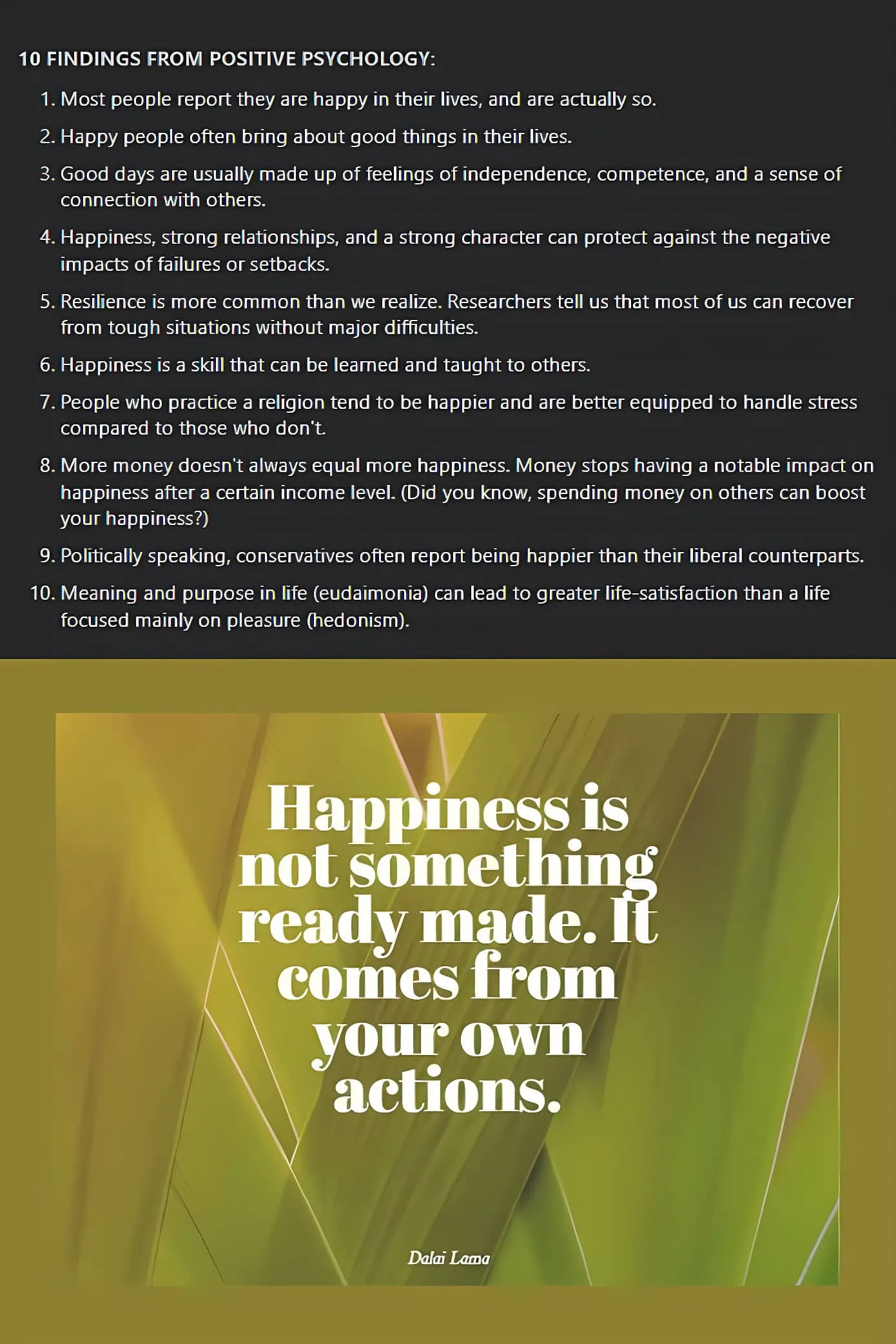
Bringing about well-being —positive emotion, engagement, purpose, positive relationships, positive accomplishment—may be one of our best weapons against mental disorder.
— Martin E.P. Seligman, Positive Health (Seligman, 2016)
10 Reasons Why Positive Psychology Matters
- Promotes mental well-being: Positive psychology focuses on enhancing mental health and reducing symptoms of depression, anxiety, and other mental health conditions.
- Builds resilience: It helps individuals develop the ability to bounce back from setbacks and adversity more effectively.
- Improves relationships: By encouraging positive social interactions, positive psychology can lead to better personal and professional relationships.
- Boosts self-esteem: Focusing on strengths rather than weaknesses can increase self-confidence and self-esteem.
- Fosters optimism: Positive psychology promotes a more optimistic outlook on life, which is associated with better health and increased longevity.
- Improves productivity: Studies show that happier, more positive people tend to be more productive at work, leading to better career outcomes.
- Manages stress effectively: Positive psychology provides tools for managing stress, promoting a healthier and more balanced lifestyle.
- Improves physical health: There is a link between positive emotions and better physical health, including lower rates of illness and faster recovery times.
- Encourages personal growth: By focusing on personal strengths and virtues, positive psychology helps individuals lead a more fulfilled and satisfied life while encouraging self-discovery and self-improvement.
- Complements traditional psychology: Positive psychology works in tandem with traditional psychology to provide a comprehensive understanding of mental health and well-being, focusing on both treating mental illness and promoting optimal functioning.
“Its value is to complement and extend the problem-focused psychology that has been dominant for many decades.”
— Christopher Peterson, A Primer in Positive Psychology, 2008
Surprising Findings In Positive Psychology
Martin Seligman writes, “Many of the findings (from the positive psychology initiative) are not of the “my grandmother already knew it” variety.”
Some surprising positive psychology findings that he mentions are:
- Genuine smiles in freshmen yearbook photos predict marital satisfaction 25 years later (Harker & Keltner, 2001).
- Short-term elevation of positive mood enhances creativity and aids quicker, more accurate diagnoses in physicians (Fredrickson, 2001; Isen, 2005).
- Wealth and life satisfaction show a curvilinear relationship; past a certain point, more wealth brings less satisfaction (Diener et al., 1993).
- In business meetings, a positive-to-negative statement ratio exceeding 2.9:1 predicts economic success (Fredrickson & Losada, 2005). (The “critical positivity ratio” has been challenged by Brown, Sokal, & Friedman, 2013).
- Positive emotion improves peripheral attention (Fredrickson & Branigan, 2005).
- High optimism drastically reduces the risk of cardiovascular death in seniors (Giltay et al., 2004). Similar findings were reported for heart attack patients (Buchanan, 1995).
- Optimism shows a protective correlation against cardiovascular events, while depression increases the risk (Kubzansky et al., 2001; Kubzansky & Thurston, 2007).
- Optimism and positive emotions aid recovery after major cardiac events (Leedham et al., 1995; Scheier et al., 1989).
- High positive affect in older men lowers the risk of frailty onset (Ostir, Ottenbacher, & Markides, 2004).
- A high level of Positive Emotional Style (PES) is linked to a lower risk of developing the common cold (Cohen et al., 2006).
- Positive affect and positive explanatory styles are protective against stroke, HIV progression, and mortality rates in the elderly (Ostir, Markides, Peek, & Goodwin, 2001; Taylor et al., 2000; Cohen & Pressman, 2006; Maruta et al., 2000).

“Flow” in Positive Psychology
According to Mihaly Csikszentmihalyi, people are at their optimal level of happiness when they are in a state of “flow.”
This is a state of complete immersion – mentally, physically, and emotionally. During flow, people are so engrossed in their activities, that they fail to notice even hunger and time.
People in flow are less concerned with external rewards; they do the activity out of sheer pleasure. Find out how to achieve the “flow” state of optimal happiness.
PERMA Theory of Wellbeing
PERMA is an acronym that stands for the five core elements of happiness and well-being proposed by Martin Seligman: Positive Emotions, Engagement, Relationships, Meaning, and Accomplishment.
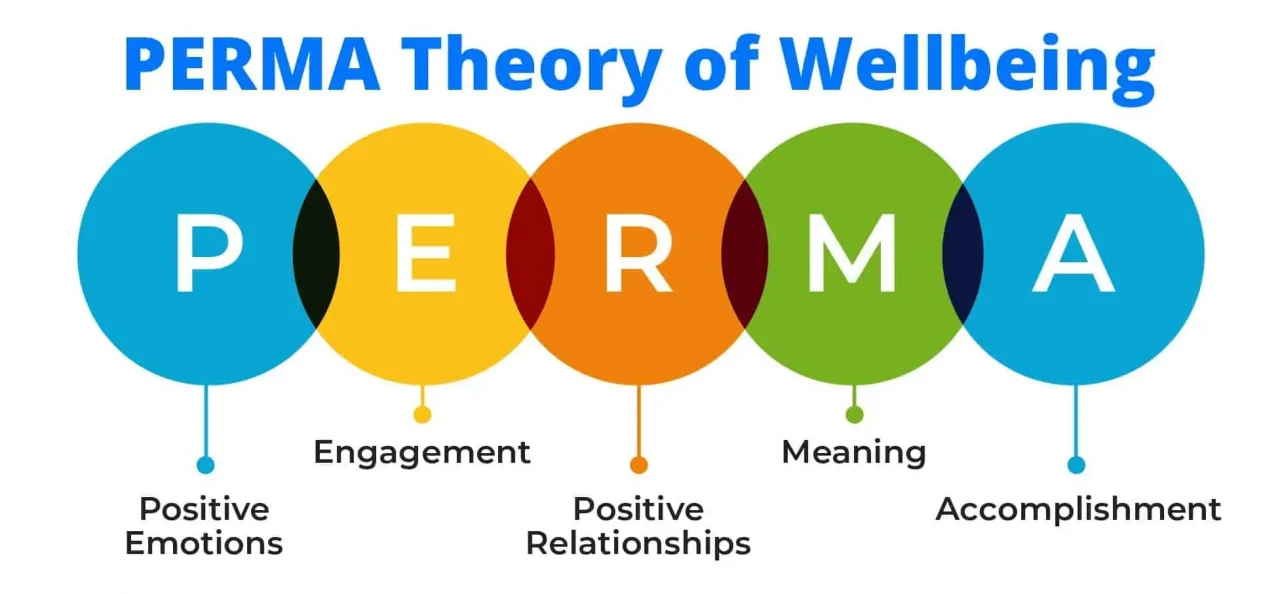
P – Positive Emotions
To have feelings of joy, pleasure, and comfort. Such positive emotions allow one to succeed and flourish in what they focus on and change their mindset to serve their highest good.
While we can not be happy all the time, we can make sure we often experience positive emotions such as pleasure, happiness, contentment, peace, joy, and inspiration.
E – Engagement
When we are fully engaged in a task or project, we experience a state of flow: a mental state in which we lose our sense of time, we lose focus of our sense of self, and we can not observe things outside the task at hand in the present moment.
Engagement closely identifies with the act of creation, but one can also experience it when playing sports, spending time with friends, or working on attention-grabbing projects. We have a greater chance of being engaged when we work from our positive character strengths, as outlined in the VIA-CSV.
R – Relationships
Humans are social beings, and good social relationships are at the core of our well-being. The strongest predictor of our happiness is the time we spend with people we care about and who care about us.
Most of our life experience revolves around other people. And research has shown that having a robust social support network reduces the risks of stress and depression, cuts down death rates, and improves health in terms of better self-care and lower self-neglect.
Building positive and supportive relationships take time and hard work, and they only form when we make active efforts to connect with others. So. commit to spending meaningful time with a friend or family member regularly.
M – Meaning
We are not here on earth only to eat, work, play, have children, and die. We are here for more. And that is finding the actual purpose of our existence.
Finding meaning in our lives is vital to our overall sense of well-being. Meaning looks at our sense of purpose and path in life, being connected to something greater than our selfish motivations and ambitions.
Those who say they have more meaningful lives also say they are relatively happy and content with their lives as a whole.
Find out How To Find The Meaning of Your Life.
A – Accomplishment
There is no question that a feeling of achievement or accomplishment gives us great satisfaction. Achieving our goals from both an external point of validation and an internal sense of success is a crucial driver of happiness.
However, if you feel your life revolves mostly around achievements and success, and the rest of your life is out of balance, then you might do well by pulling back and focusing on the other elements of the PERMA Model.
Find out what the Cross-Cultural Comparison of The PERMA Model of Wellbeing says.
Seligman’s TED Talk On Positive Psychology
Martin Seligman, the founding father of positive psychology, in his 2004 TED Talk says:
The first happy life is the pleasant life. This is a life in which you have as much positive emotion as you possibly can, and the skills to amplify it. The second is a life of engagement: a life in your work, your parenting, your love, your leisure; time stops for you. That’s what Aristotle was talking about. And third, the meaningful life.
The “Hamburger” Model of Happiness
Tal Ben-Shahar first conceived the “Hamburger” Model of Happiness when he sat down to eat four burgers after winning the Israeli National Squash Championship in 1986. He later developed this model while at Harvard, from where he graduated in philosophy and psychology, and later, did his Ph.D. in Organizational Behavior.
The “hamburger” model represents four different hamburgers and how they relate to how happy a person is.
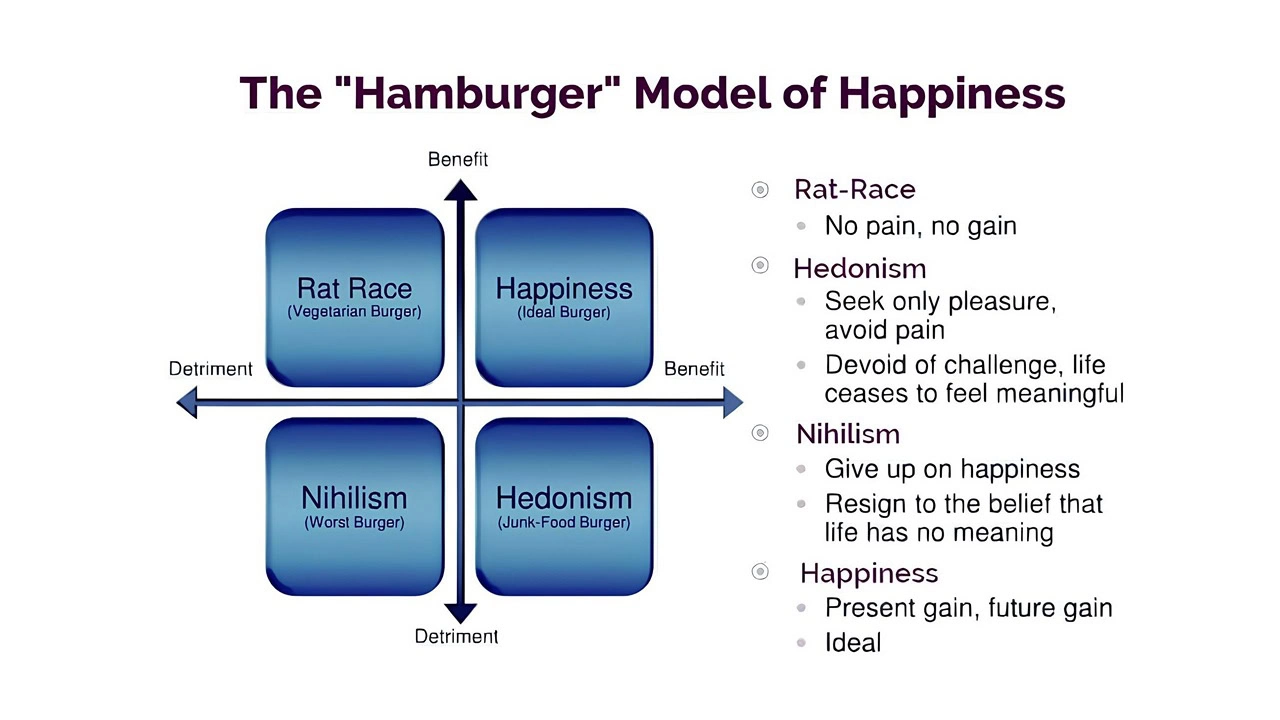
1. Rat-Racer: Eats The Vegetarian Burger
It is a healthy but not tasty burger. It relates to people who only know pain and discomfort as the path to future happiness. All they want is future unhappiness, and sacrifice all present moments of joy for that.
The problem is that such people begin to believe happiness is something that we can only achieve in the future. They live according to the principle of present-pain for future-profit and renounce the present joys to benefit in the future.
But once the future arrives, it mostly doesn’t look like what they expected it to look like. Meanwhile, this person is still too busy to enjoy the moment and pushes away the joys even farther into the future.
Their lives have become a rat race. A rat race is an endless, self-defeating, or pointless pursuit. They live in a constant struggle for survival and the pursuit of profit at the expense of the joys and pleasures of life today.
2. Hedonist: Eats The Junk Food Burger
It is a tasty but unhealthy burger. It relates to people who only know pleasure as the only path to happiness. They want to be happy now at the cost of future unhappiness.
When people get asked what a happy life means to them, they often think of a life full of joy and devoid of pain. These are the hedonists – who live only in the moment and worry little about future consequences.
To understand this, suppose you ate your favorite food every time. Can you enjoy the experience of eating the same food for breakfast, lunch, and dinner for weeks on end? Instead, why not ask yourself how long it would take you to get sick of it?
Similarly, what would happen if your life was always about pleasure? You would utterly fail to distinguish one pleasurable activity from the other. Such a life would soon become empty and stale.
3. Nihilist: Eats The Worst Burger
It is a tasteless and unhealthy burger, and obviously, the worst kind. It relates to people who believe their lives are pointless and can never be happy. So, they are always miserable and demoralized, having lost all hope of happiness.
A phenomenon called “learned helplessness” shows how easy it is to learn you have no control over your own life and that every effort of yours will go futile. When you ask yourself why you would eat this kind of burger, the only explanation you can give is that your life is pretty pointless.
You give up the present and the future, both. You spend time thinking about what could go wrong in the future as well as ruminating over what things went wrong in your past life.
Ben-Shahar describes this desperate place as “nihilism,” but fortunately, we can turn around learned helplessness into Learned Optimism.
4. Happiest: Eats The Ideal Burger
It is a healthy and tasty burger. It applies to people who know how to be happy in the present, as well as in the future. It represents those who have reached fulfillment and purpose in their life.
It is a place where you can enjoy a healthy dose of self-indulgence, a bit of fun, and a lot of good food.
It sounds simple, but there are two crucial points:
- First, take a moment to rethink your personal definition of happiness, and be careful if you think you want to experience pure bliss for the rest of your days. Leading psychiatrist Dr. Raj Persaud suggests that we really should aim for nothing more than “mild contentment,” and that’s about as good as it gets.
- Second, ask yourself, does your definition of happiness include activities as well as feelings? If not, rethink your definition. If you want to be happy, then you have to do things that create meaning and purpose in your life.
The paradox is that when we accept our feelings — when we give ourselves permission to be human and experience painful emotions — we are more likely to open ourselves up to positive emotions.
— Tal Ben-Shahar
VIA-CSV Directory of Positive Psychology
To counteract the traditional focus of psychology on diseases, Martin Seligman (Father of Modern Positive Psychology), and Christopher Peterson, standardized the principles of positive psychology in the book Character Strengths and Virtues: A Handbook and Classification.
The VIA (Values In Action) Classification of Character Strengths and Virtues (by VIA® Institute on Character) is Positive Psychology’s counterpart to the Diagnostic and Statistical Manual of Mental Disorders (DSM) used in traditional psychology and psychiatry.
Just as the DSM, presently in its 5th version called DSM-5, identifies and classifies psychiatric disorders, the CSV details and classifies the various human strengths that help people thrive.
The VIA-CSV allows people to pinpoint their strengths and weaknesses of character and learn how to work on them. The VIA-CSV identifies the 24 character strengths, organized under 6 overarching virtues — Wisdom and Knowledge, Courage, Humanity, Justice, Temperance, and Transcendence. It consists of 240 questions.
Positive Psychology Criticism
Positive psychology has its critics and detractors.
- Lazarus (2003) claimed that positive psychologists “attack the psychology of the past to create the illusion that what they offer is new and different.”
- James Coyne has also been critical of PP, particularly some of its interventions (Coyne, 2010).
- Barbara Ehrenreich (2010) argued that pressuring people to be happy can cause more harm than good, and her claims get support from recent research.
- Barbara Oettingen’s findings suggest that some types of positive thinking predict maladaptive outcomes.
- Wong & Roy (2018) offer a comprehensive critique of positive psychology in Critique of Positive Psychology and Positive Interventions. The second author, Roy, is the founder of The Happiness Blog.
PP 2.0 (Second Wave Positive Psychology or PP 2.0)
Psychology preoccupied itself with the negative (the thesis). Positive psychology (now referred to as PP 1.0 or First Wave Positive Psychology) challenged it by focusing on the positive (the antithesis).
Second Wave Positive Psychology (PP 2.0), a concept proposed by Paul T. P. Wong, 2011, suggested that we should focus on both the negative and the positive aspects of human existence, as both can result in the same positive outcomes. In doing so, PP 2.0 united Psychology and PP 1.0 by incorporating aspects of both into a new position that transcended and extended the original viewpoints (Mills, 2000).
PP 2.0 is distinguished by two elements:
- Existential positive psychology, with suffering as the foundation for happiness and well-being, and
- Indigenous psychology, with the Yin-Yang concept as an Asian perspective on well-being.
Positive psychology 2.0 is also an attempt to counter-challenge the critics of positive psychology, as it integrates PP 1.0 with humanistic-existential psychology.
What separates PP 2.0 from PP1.0 is not just the identification of positive potentials in negative emotions, but also an important emphasis on humanistic values, the dark side of human existence, and dialectical principles (Ivtzan et al., 2015; Wong, 2011).
25 Positive Psychology Terms
A glossary of twenty-five important terms in positive psychology:
- Affective Forecasting: People consistently overestimate their emotional reactions to future events.
- Autonomy: the belief that we are reasonably in control of what happens to us (rather than others, fate, or luck being in total charge).
- Broaden-and-Build Theory: Describes how positive emotions open up our thinking and actions to new possibilities, and how this expansion can help build well-being. Proposed by Barbara Fredrickson.
- Engaged Life: Happiness focused on involvement in activities, and the ability to express talent, strengths, and purpose.
- Flourishing: Living optimally and striving for well-being in terms of positive emotions, pleasure, engagement, good relationships, meaning and purpose, and accomplishments. Filled with vitality and functioning well in personal and social life. People who flourish score high on emotional, social, and psychological well-being, and low on mental illness.
- Gratitude: A sense of thankfulness and happiness in response to receiving a gift, either a tangible benefit given by someone or a fortunate coincidence.
- Hedonic Treadmill: The belief that people are doomed to a certain level of happiness. People will experience “positive affects” but will later return to an average level of happiness.
- Languishing: A state of emptiness, stagnation, quiet despair, absence of purpose in life, and lack of mental health; a languishing person shows ennui, apathy, listlessness, and loss of interest in life.
- Love: According to Barbara Fredrickson, “Love is a momentary upwelling of three tightly interwoven events: first, a sharing of one or more positive emotions between you and another; second, a synchrony between your and the other person’s biochemistry and behaviors; and third, a reflected motive to invest in each other’s well-being that brings mutual care.” According to the triangular theory of love, it consists of three essential components: passion, intimacy, and commitment.
- Maximizing: Getting or trying to get the best possible option in any situation. Sufficing: Getting what they need, but settling for something that isn’t the best, but still gets the job done.
- Meaning (Transcendence): The three needs for meaning are purpose, value, and self-efficacy.
- Meaningful Life: Happiness that is derived from going beyond self-interests, like religious community, charity, or political cause. Connection to something “larger than the self.”
- Pleasant Life: The “good” life where people are happy, content, and fulfilled.
- Positive Affect: Refers to emotions such as cheerfulness, joy, contentment, and happiness. Negative Affect: Refers to emotions such as anger, fear, sadness, guilt, and disgust.
- Positive relationships: The ability to form and maintain supportive, warm, and trusting relationships with others.
- Post-traumatic Growth (PTG): Experiencing an increased appreciation of life, etc. following trauma. Overcome challenges of belief in personal invulnerability, perception of a meaningful world, and the view of ourselves as positive.
- Psychological Well-Being: includes Self-Acceptance, Personal Growth, Purpose, Autonomy, Positive Relations, and Mastery.
- Resilience: Characterized by good outcomes, despite serious threats to adaptation or development. “Maintenance, recovery, or improvement in mental/physical health following a challenge.”
- Savoring: The capacity to attend to, appreciate, and enhance positive experiences in life.
- Self-Acceptance: the ability to like and accept most things about ourselves.
- Self-Determination Theory (SDT): States that well-being and happiness result from the fulfillment of three basic psychological needs: Autonomy, Competence, and Relatedness (close connections to others).
- Strength: A positive trait or quality of character considered morally good and valued for itself as well as for promoting individual and social well-being. Worldwide, the strengths most associated with satisfaction in life are hope, zest, gratitude, and love. Researchers call these strengths of the heart.
- Subjective Well-Being (SWB): Involves life satisfaction, the presence of positive affect, and the relative absence of negative affect. Associated with hedonic happiness.
- The Good Life: A combination of three elements: connections to others (as love, altruism, forgiveness, spirituality), positive individual traits (as honesty, playfulness, creativity, courage, humility), and life regulation qualities (a sense of individuality or autonomy, healthy self-control, wisdom).
- Virtue: A character trait that makes it possible for people to pursue worthwhile goals and is beneficial to one’s psychological health.
Definitions of Positive Psychology
Positive psychology is the scientific study of the strengths that enable individuals and communities to thrive. The field is founded on the belief that people want to lead meaningful and fulfilling lives, to cultivate what is best within themselves, and to enhance their experiences of love, work, and play.
— The Positive Psychology Center at the University of Pennsylvania
Positive psychology is not a self-help movement or a re-packaging of “the power of positive thinking.” It is not American-style “happy-ology,” and it is not a passing fad. Positive Psychology is a science that brings the many virtues of science … to bear on the question of how and when people flourish.
— Robert Biswas-Diener, 2008
Positive psychology is the scientific study of human flourishing and an applied approach to optimal functioning. It has also been defined as the study of the strengths and virtues that enable individuals, communities, and organizations to thrive.
— Sheldon and King, 2001, Gable and Haidt, 2005
Positive psychology is the opportunity to change the happiness of the world.
— Acacia Parks, Assistant Professor of Psychology at Hiram College and Chief Scientific Advisor at Happify
Positive psychology is all about the study of what’s right with people.
— Alex Linley, co-author of Adolescence Life Satisfaction
Positive psychology is exactly the study of what goes right in people’s lives.
— Kathryn Britton, Speaker, Coach, and Teacher of Positive Psychology
Positive psychology is the science of happiness. More specifically, positive psychology is about focusing on what works … on love, happiness, strength, and virtues.
— Tal Ben-Shahar, Founder at Happiness Studies Academy, Former lecturer at Harvard
Positive psychology is a way of looking at things … in a strengths-based way. We begin to look at people and ourselves from the perspective of their and our best qualities, so that our behaviors, our feelings, our thinking is curious, fair-minded, grateful.
— Ryan Niemiec, Education Director of the VIA Institute on Character
Positive psychology looks at what works well with people, what makes people happy, what makes people flourish, what makes people resilient, what makes people have great relationships, and what makes people find meaning in their lives.
— Lisa Sansom, Executive Director at Queen’s University and Positive Interventionist
Positive psychology is the scientific study of wellbeing or the scientific study of what makes life worth living. It is the possibility of giving language to a huge range of the best of human experience.
— Piers Worth, Associate Professor (the local title is “Reader”) in Psychology
Positive psychology is the study of how to bring out the best in people and organizations, in spite of the dark side of life. I believe the best way to achieve the objective of our technology is to increase the dark side of human existence. So if we want to optimize wellbeing, we have to learn to manage the upside of the dark side, and the dark side of the bright side.
— Paul T. P. Wong, Founder, and President of the International Network On Personal Meaning
Positive psychology is the study of positive states and positive traits and positive institutions that support these two.
— Angela Duckworth, Christopher H. Browne Distinguished Professor of Psychology at the University of Pennsylvania
Best Online Courses On Happiness & Positive Psychology
Here are the best online courses on the science of happiness and well-being, or positive psychology:
- 10 Days of Happiness by Action For Happiness (Free)
- A Life of Happiness and Fulfillment by ISB via Coursera
- The Science of Well-Being by Yale University via Coursera
- Positive Psychology by Dr. Barbara L. Fredrickson via Coursera
- Positive Psychology by American Psychological Association via edX
- The Science of Happiness by University of California, Berkeley via edX
- Be Happier with Positive Psychology by Andrew Luttrell, Ph.D. via Udemy
- Positive Psychology Course by Tal Ben-Shahar at Harvard via OpenCulture
- Positive Psychiatry and Mental Health by The University of Sydney via Coursera
- A Life of Happiness and Fulfillment by Dr. Rajagopal Raghunathan via Coursera
- Positive Psychology by The University of North Carolina at Chapel Hill via Coursera
- Positive Psychology by Indian Institute of Technology Delhi and NPTEL via Swayam
- Positive Psychology: Martin E. P. Seligman’s Visionary Science by UPenn via Coursera
- Mindfulness for Wellbeing and Peak Performance by Monash University via FutureLearn
- The Path to Happiness and Good Quality of Life by Universidad de Palermo via FutureLearn
- Positive Psychology: Applications and Interventions by University of Pennsylvania via Coursera
- The Science of Happiness and Wellbeing by Indian Institute of Technology, Kharagpur via Swayam
Books on Happiness Science/Positive Psychology
- Flow: The Psychology of Optimal Experience by Mihaly Csikszentmihalyi
- Authentic Happiness: Using the New Positive Psychology by Martin Seligman
- Positive Psychology In A Nutshell: The Science Of Happiness by Ilona Boniwell
- Happier: Learn the Secrets to Daily Joy and Lasting Fulfillment by Tal Ben-Shahar
- The Happiness Hypothesis: Finding Modern Truth in Ancient Wisdom by Jonathan Haidt
- Switch On Your Brain: The Key to Peak Happiness, Thinking, and Health by Dr. Caroline Leaf
- Flourish (A Visionary New Understanding of Happiness and Well-Being) by Martin Seligman
- The How of Happiness: A New Approach to Getting the Life You Want by Sonja Lyubomirsky
- The Happiness Advantage: How a Positive Brain Fuels Success in Work and Life by Shawn Achor
- Habits of a Happy Brain: Retrain Your Brain to Boost Your Serotonin … by Loretta Graziano Breuning
Positive Psychology Websites
- The Happiness Blog
- Positive Psychology Tools
- Greater Good Magazine by GGSC
- Mexican Positive Psychology Association Blog
- New Zealand Association of Positive Psychology Blog
- Positive Psychology Center at the University of Pennsylvania
- PositivePsychology.com by Seph Fontane Pennock & Hugo Alberts
- The Journal of Positive Psychology — Research on positive psychology, optimal human functioning, and fulfillment.
If you’re keen to know more, take a look at the University of Pennsylvania’s site Authentic Happiness and Positive Psychology Center.
Further Reading
- Read this excellent chapter by Dr. Happy: Happiness: The Science of Subjective Well-Being.
- Seligman, Martin (1990). Learned Optimism: How to Change Your Mind and Your Life. Free Press.
- Dalai Lama; Cutler, Howard C. (1998). The Art of Happiness. New York: Riverhead Books. ISBN 978-1-57322-111-5.
- Tayfun, Doğan & Aydın, Fatma Tuba. (2021). Do Happy Children Become Happy Adults? Journal of Humanity and Society. 11. 69-96. 10.12658/M0437.
- Snyder, C. R.; Lopez, Shane J. (2001). Handbook of Positive Psychology. Oxford University Press.
- Argyle, Michael (2001). The Psychology of Happiness. London: Routledge.
- Kahneman, Daniel; Diener, Ed; Schwarz, Norbert, eds. (2003). Well-Being: The Foundations of Hedonic Psychology. New York: Russell Sage Foundation Publications. ISBN 978-0-87154-424-7.
- Keyes, Corey L. M.; Haidt, Jonathan, eds. (2003). Flourishing: Positive Psychology and the Life Well-lived. Washington: American Psychological Association. pp. 275–289. ISBN 978-1-55798-930-7.
- McMahon, Darrin M. (2006). Happiness: A History. New York: Atlantic Monthly Press. ISBN 978-0-87113-886-6.
- Kashdan, Todd; Biswas-Diener, Robert (2014). The Upside of Your Dark Side: Why Being Your Whole Self–Not Just Your “Good” Self–Drives Success and Fulfillment. New York: Hudson Street Press. ISBN 978-1594631733.
- Stebbins, R. A. (2015). Leisure and Positive Psychology: Linking Activities with Positiveness. Houndmills, England: Palgrave Macmillan.
- Robbins, Brent Dean (2008). “What Is the Good life? Positive Psychology and the Renaissance of Humanistic Psychology” (PDF). The Humanistic Psychologist. 36 (2): 96–112.
Final Words
Download the PDF of this post here.
Everyone’s life has both highs and lows. Positive psychology believes life is more than just avoiding or undoing the troubles that come with the lows. Its main premise is this:
The good things about life are as important as the bad ones. Therefore, they deserve similar attention from the science of psychology.
√ Also Read: 10 Happiness Myths You Should Let Go
√ Please spread the word if you found this helpful.
• Our Story!
